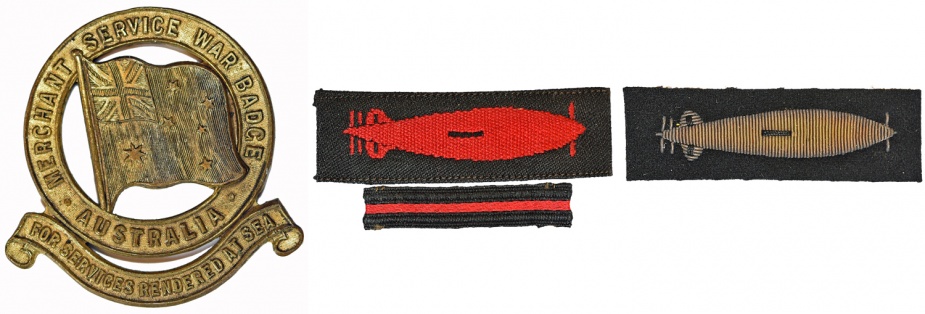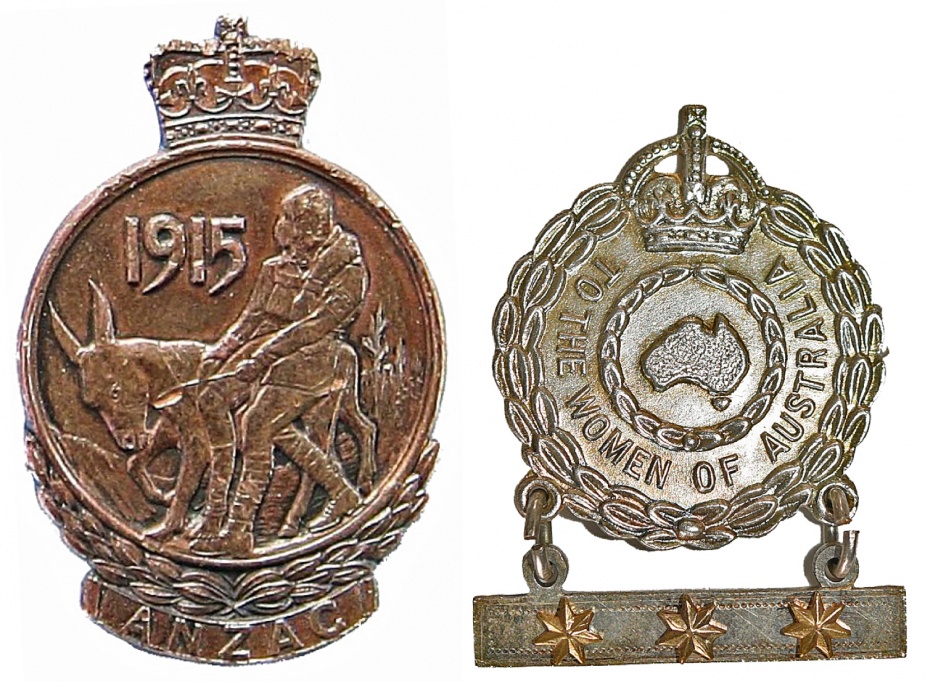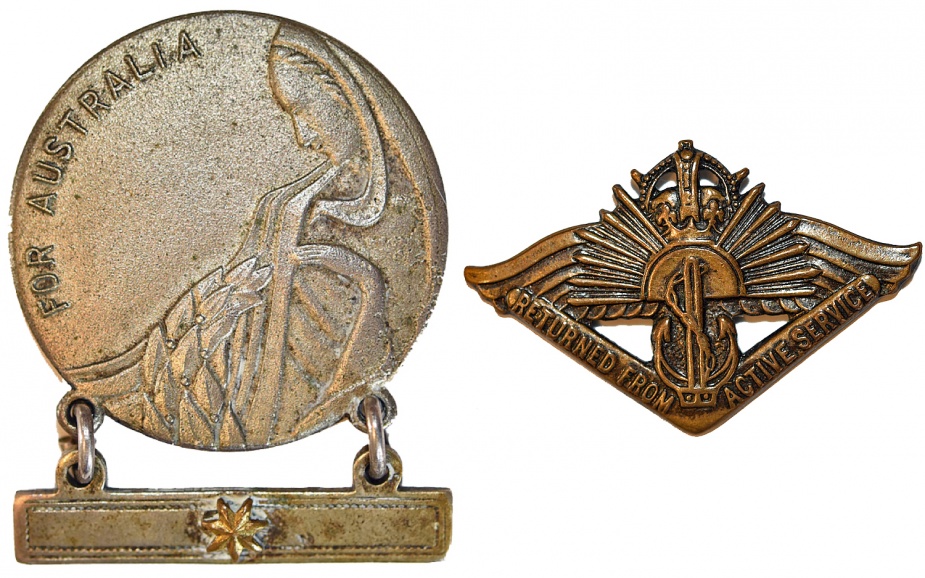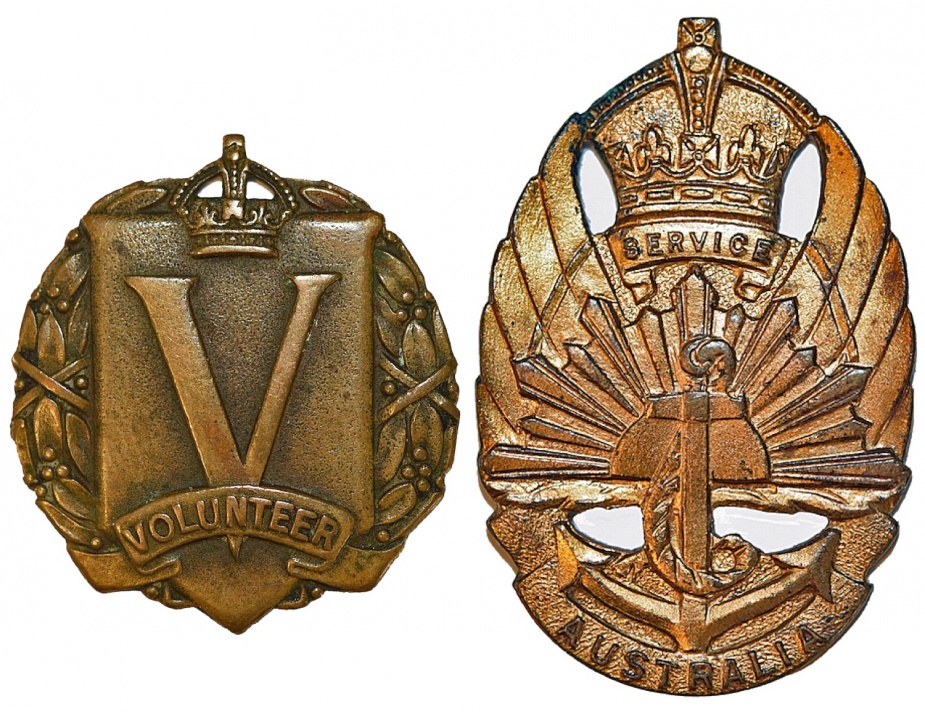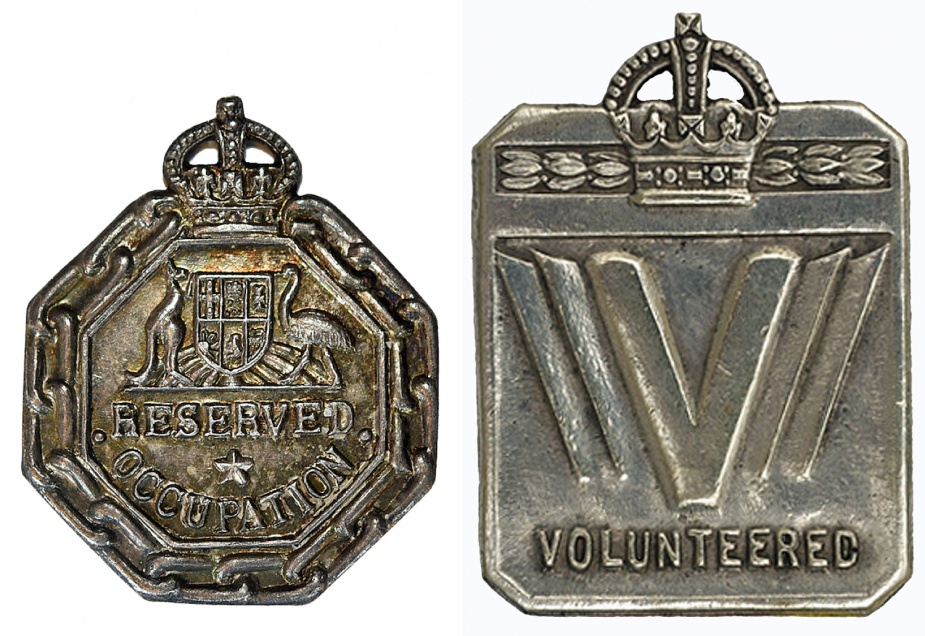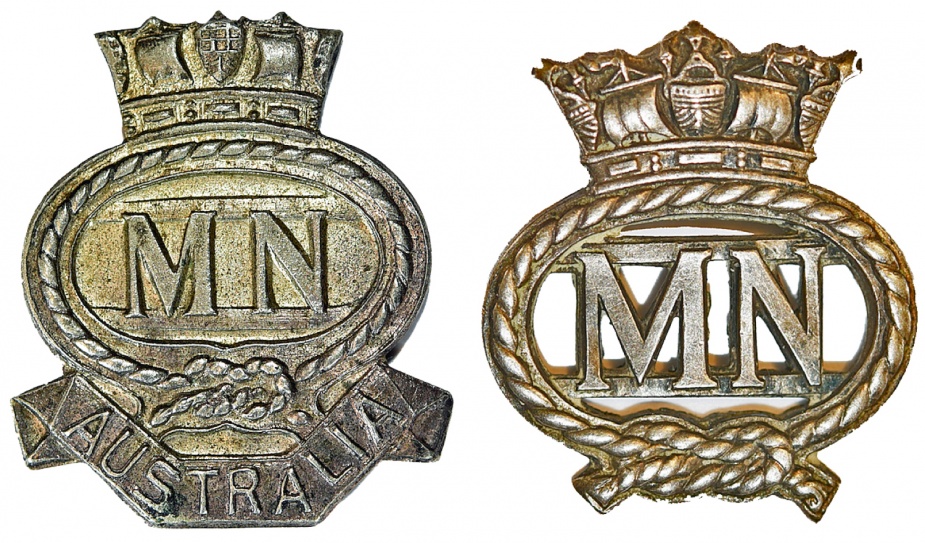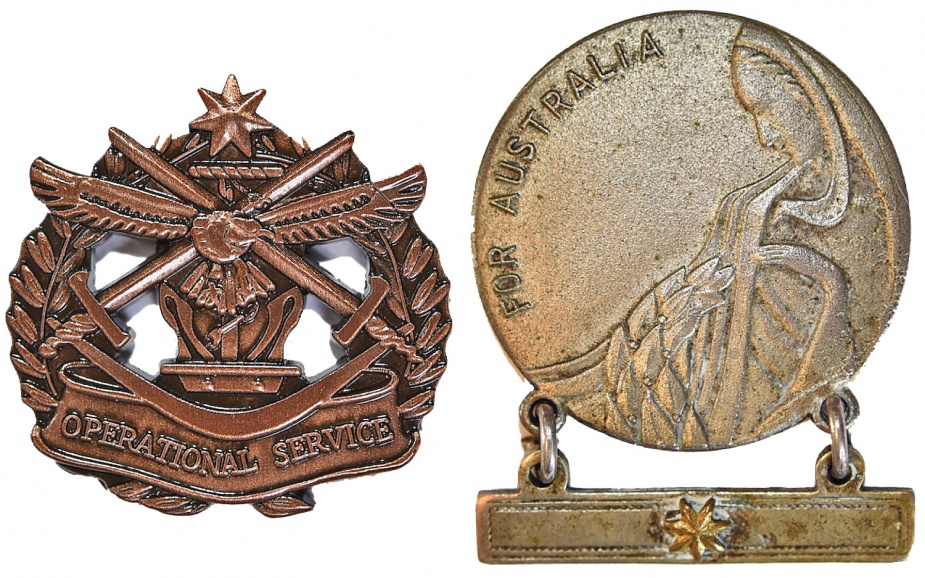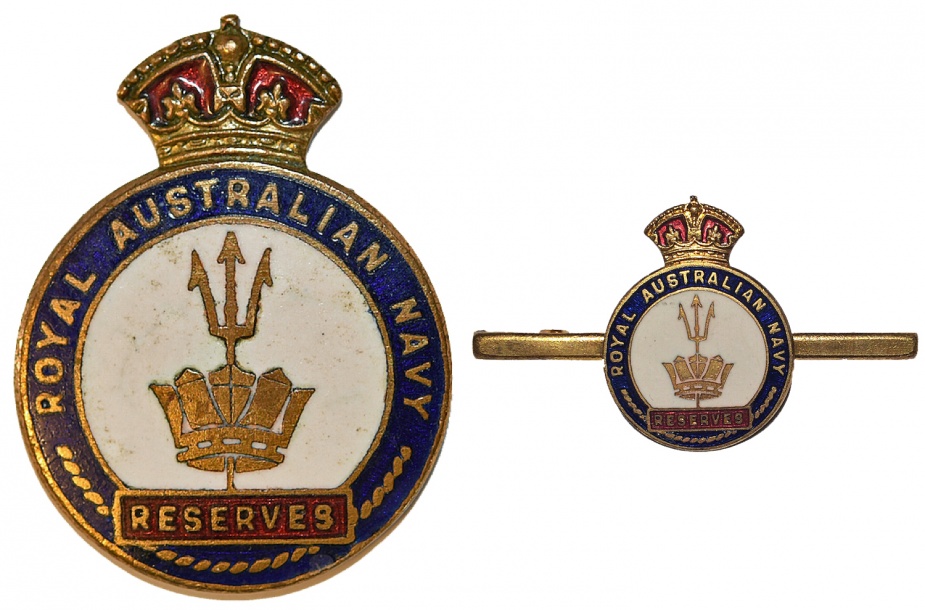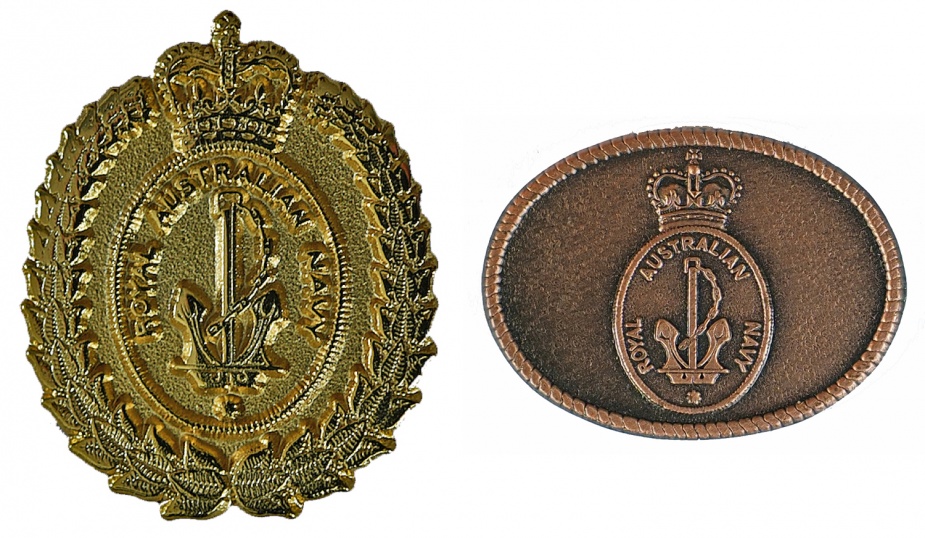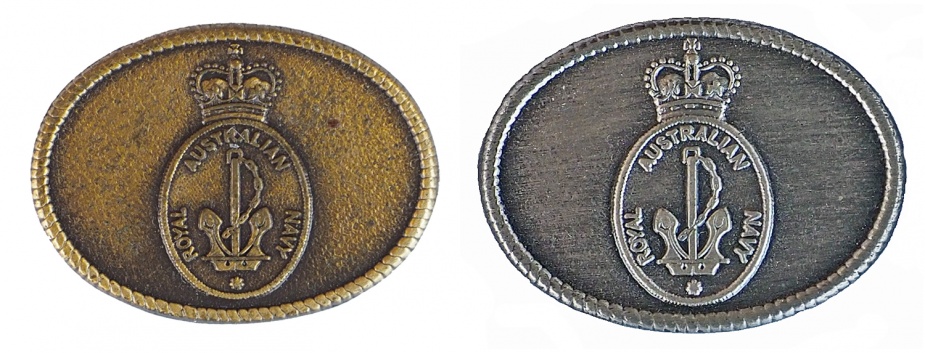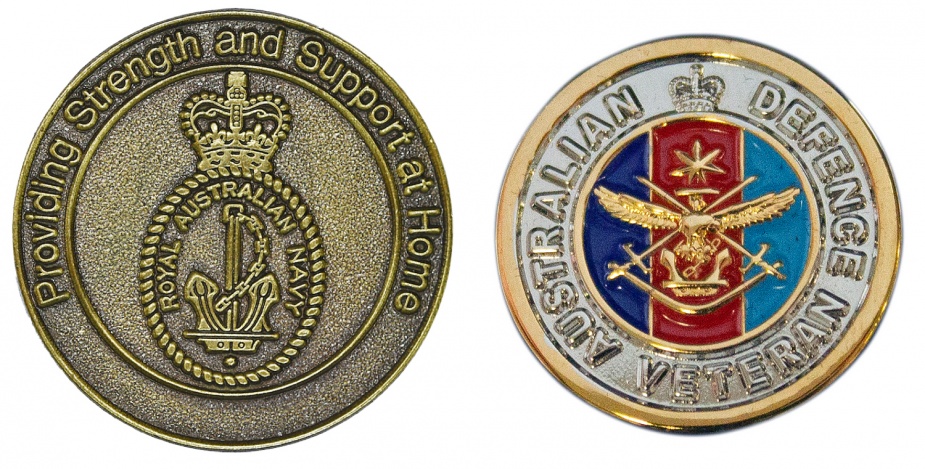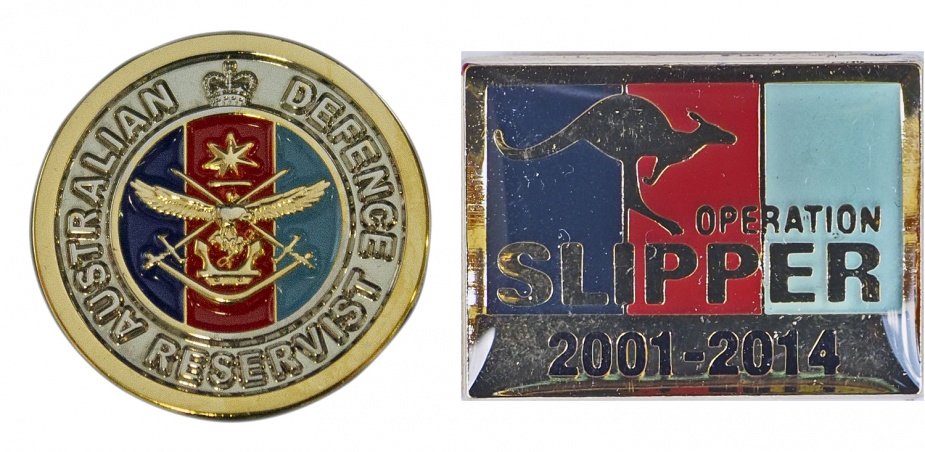Navy Recognition of Service Badges
by Dr Jozef Straczek
Every year on Anzac Day thousands of Australian men and women can be seen marching in the streets of Australia’s cities and towns and gathered around small country town cenotaphs. On their chests they proudly display their or their family’s record of service and sacrifice to the nation. A day later these same people seem to melt into the crowd and disappear. Yet the symbols of their service are still there, though not as obvious as the shining medals and multicoloured ribbons.
Since the First World War the Australian government has been presenting a variety of badges, for wearing in civilian clothing, reflecting the wearer’s status as having either served in the Australian Defence Forces or Reserves, returned from active service, volunteered for service or being a family member of a person who has served or died as a result of that service.
The following represent the various service and home front badges issued by either the Department of the Navy, the Department of Defence or the Commonwealth Government to naval or merchant navy personnel, their relatives, or civilian employees of these Departments since the First World War. British badges which either Royal Australian Navy or merchant navy personnel would be entitled to are also illustrated.
Commemorative badges have been placed at the end of the conflict for which they were given.
The assistance and suggestions of Mr Brett Mitchell, Directorate of Honours and Awards is also acknowledged.
First World War Badges
Mother’s and Widow’s Badge
The Mother’s and Widow’s Badge was awarded to the mother and/or widow of members of the RAN who were killed in action, died of wounds or other causes whilst on active service. An award was also made if the individual died from war related causes after discharge. The badge was issued only after an application was submitted.
Eligibility of the award was also extended to include the mother and/or widow of Royal Navy personnel who were on loan to the RAN.
Each death of a family member was indicated by the addition of a Federation Star.
Badges for mothers and widows of members of the Royal Australian Navy Bridging Train were issued by the Department of Defence and not the Navy Department as the personnel were viewed as being part of the Australian Imperial Force.
Status: No longer awarded.
Source Documents:
- Commonwealth Navy Order 51/1919.
- NAA: A6990, 1, Badges Granted in Australia for Service in the Great War of 1914-1918.
Female Relative’s Badge
The Female Relative’s Badge was issued to the mother or nearest female, blood, relative of a person who had enlisted in the RAN or a naval member of the Australian Naval and Military Expeditionary Force which captured German New Guinea. Badges were also issued in respect of members of the Royal Australian Navy Brigade and the Auxiliary Services where these persons had enlisted for general active service at sea and had served in a seagoing warship. Service in training ships did not count.
Female relatives living in Australia where the husband, son or male relative was serving in the Royal Navy, Royal Naval Reserve or Royal Naval Voluntary Reserve were also eligible to receive the badge.
In March 1918 eligibility for the badge was extended to the RANB Minesweeping Section where they had spent time at sea undertaking actual minesweeping operations and not training.
Female relatives of RANBT personnel were required to apply for a badge through the Department of Defence as the Bridging Train was deemed to be part of the AIF.
Entitlement to the badge was based on the following:
- For a married sailor the badge is issued to his wife. The mother of a married sailor could also receive a badge for his service.
- For a widower the badge is issued to the eldest daughter.
- For a widower, with no daughter, the badge was awarded to his eldest sister.
- If the sailor was unmarried then the degrees of relationship were determined to be mother followed by his eldest sister.
- If the sailor had no female relatives as described, then he had to nominate his nearest female blood relative.
Mothers were entitled to the award of an additional silver bar, suspended below the badge, in recognition of the service of a second son. In the case of where a husband enlisted and then a son, a bar would also be awarded.
Notwithstanding the possibility of being eligible to receive more than one badge only one badge was issued to each female. However, because badges were issued by both the Department of Defence (on behalf of the AIF) and the Department of the Navy it was possible for a female to receive one of each badge.
Status: No longer awarded.
Source Documents:
- Commonwealth Navy Orders 5/1918; 34/1918.
- NAA: MP472/1, 1/18/4412, Persons Entitled to Female Relative’s Badge.
- NAA: A6990, 1, Badges Granted in Australia for Service in the Great War of 1914-1918.
RAN Returned Sailors’ Badge
A Returned Sailors’ Badge, also described as a Returned from Active Service Badge, was authorised for members of the RAN along a similar vein to the badge issued to the AIF. As the Navy was a permanent force all members of the sea-going forces who had served at sea between 5 August 1914 and 11 November 1918 were eligible for the badge. The exception to this were members who had been discharged either Services No Longer Required, for disciplinary reasons, or who as a result of their own neglect or misconduct had been discharged for medical reasons. Personnel who had been discharged ‘at own request’, prior to the Armistice, for compelling personal or compassionate reasons had to have served afloat for at least 12 months.
Initially members of the RANB who were engaged for short periods in patrol or other vessels were not entitled to the badge. However, the eligibility, for RANB members, was extended to include those who served continuously in a commissioned warship for a period of six months between 5 August 1914 and 11 November 1918.
The issuing policy was changed again in 1921 when it was decided that the badge could be issued to any member of the Commonwealth Naval Forces who were eligible, under Admiralty Regulations, for the award of the Victory Medal. RAN nurses who served onboard the hospital ship HMAS Grantala during the assault on German New Guinea were also eligible to receive this badge.
These badges carried a numerical serial number on the back. In later badges the serial number is preceded by the letter N. Badges with an N prefix appear to have been ordered after 1920.
As overseas service chevrons were worn on naval uniform this badge was only to be worn when in civilian clothing.
Status: No longer awarded.
Source Documents:
- Commonwealth Navy Orders 178/1918; 189/1918; 191/1918; 26/1919; 65/1919; 146/1919; 218/1921.
- NAA: A13292, 1, Returned Sailors Badges 1914-1918 Original Issues and Replacements.
- NAA: A6990, 1, Badges Granted in Australia for Service in the Great War of 1914-1918.
Returned Sailors’ Badge - Royal Navy
In 1919 the Australian Commonwealth Naval Board approved the issue of Returned Sailors’ Badges to officers and men of the RN who had been lent or transferred to the RAN subsequent to 11 November 1918. The entitlement for badges to these personnel ceased on 30 June 1919. After 30 June the badges were issued only to those RN personnel who were discharged to shore in Australia.
Other eligibility criteria for this award were that the individual had to have had active service afloat in RN ships prior to the Armistice. Additionally, those discharged to shore in Australia for reasons of misconduct were ineligible for the badge.
As the eligible personnel had not served in the RAN the Naval Board authorised the production of a modified Returned Sailors’ Badge. The badge differed from the RAN Returned Sailors’ Badge in that the letters ‘RAN’ were omitted from it. The Naval Board ordered 100 of these badges from Stokes & Sons, Melbourne in May 1919. Of the badges ordered 99 were recorded as being issued.
Status: No longer awarded.
Source Documents:
- Commonwealth Navy Order 103/1919.
- NAA: MP472, 1/18/8202, Badges for Issue to Members of the RAN B Retained on Home Service.
- NAA: A13292, 1, Returned Sailors Badges 1914-1918 - Original Issues and Replacements.
Silver War Badge
The Silver War Badge was an Imperial award approved by the King George V in 1917. The badge was issued to those, including members of the RAN and RAN Reserves, who had been in service since 4 August 1914 and invalided out of the service as a result of wounds or injuries received during war service and served for a period of not less than six months. Medical and dental practitioners who rendered full-time service on naval vessels or vessels under naval control were also eligible for the award.
Personnel who had qualified for the badge but subsequently re-enlisted were not issued with a badge. The badge was to be worn in civilian clothing.
The badges are numbered and those issued to Australians carry an A prefix. If the recipient lost his badge a replacement was not officially issued, though there are commercially manufactured badges in existence marked ‘REPLACEMENT’.
Merchant seamen were also eligible for the badge. The eligibility criteria for merchant seamen were:
- Injury resulting from any hostile act by an enemy.
- Illness or shock from being torpedoed or attacked.
- Strain due to war conditions which resulted in nervous, mental or physical strain a result of which the seaman was unfit for further service.
- Disease, such as malaria and dysentery, resulting from the service in unhealthy climates.
Merchant seamen applications were sent to the British Board of Trade representative in Australia and not the Navy.
Status : No longer awarded.
Source Documents:
- Commonwealth Navy Orders 30/1917; 33/1918.
- NAA: A6990, 1, Badges Granted in Australia for Service in the Great War of 1914-1918.
Home Service Badge
In November 1918 the ACNB decided that a service badge would be issued to members of the RANB who had been retained for service in Australia. Eligibility for the badge appears to have been subsequently expanded to include members of the RAN who were retained for service in Australia.
This badge was issued to uniformed personnel only. Civilian employees who qualified were issued with the Volunteered for Active Service - Retained for Home Service Badge.
There was no equivalent badge issued to either the Australian Commonwealth Military Forces or the AIF. The Commonwealth Military Forces were prohibited from serving overseas and the AIF was raised specifically for overseas service.
Status: No longer awarded.
Source Documents:
- Commonwealth Navy Order 178/1918.
- NAA: A13292, 1, Returned Sailors Badges 1914-1918 Original Issues and replacements.
- NAA: MP472/1, 1/18/8198, Badge for Issue to RANB Retained on Home Service in Australia.
- NAA: A6990, 1, Badges Granted in Australia for Service in the Great War of 1914-1918.
Volunteered for Active Service - Retained for Home Service Badge
In October 1916 the Naval Board decided that all permanent employees of the Department of the Navy were exempt from military service as their work was of national importance. In the case of temporary employees only those who were urgently needed for the war effort were retained.
A Retained for Home Service Badge was issued by the Department of the Navy to civilian employees who volunteered for active service but, as a result of the Naval Board decision, were required to remain in their positions within the Department.
The Department of Defence issued a similar badge to its employees who had volunteered for active service but were retained by the Department. Two other ‘Volunteered For Active Service’ Badges were also issued by the Department of Defence. One was for Munitions Workers and the second to men who volunteered for active service and were deemed to be medically unfit.
The Department of the Navy did not issue badges equivalent to these two. With respect to Medically Unfit or Reject Badges the Naval Board stated in Commonwealth Navy Order 190/18 that such a badge would not be issued.
Status: No longer awarded.
Naval Transport Coaling Battalion Badge
Established in June 1916, the Naval Transport Coaling Battalion was to provide a body of men to coal transports and hospital ships. The agreement between the Minister for the Navy and the Coal Lumpers Union ensured that there would be no disruption to the process of coaling transports and hospital ships. It also gave the Navy first call on the men, irrespective of their employment at that time. Members of the Coaling Battalion were deemed to have enlisted for war service and were issued with a badge to indicate this. These badges were issued with the intent that they be returned when the individual left the Coaling Battalion.
In 1917, under a reorganisation of the Navy, the Coaling Battalion became part of the Citizen Naval Force. The Coaling Battalion officers were granted honorary rank as part of the RANB. These changes were to take effect on 1 January 1917.
Following disbandment of the Coaling Battalion formal attempts were made by the Navy to retrieve the issued badges. These were not very successful.
Status: No longer awarded.
Source Documents:
- Commonwealth Navy Order 1/1917.
- Statutory Rules 1916 No. 136 - War Precautions (Coaling Battalions) Regulations 1916.
Transport Service Badge
The Transport Service Badge was issued to non-enlisted personnel, between the ages of 18 and 45, who were employed on board transports during the war. The initial issue of the badges was apparently made in 1917 through the Port of Melbourne Authority.
Status: No longer awarded.
Source Documents:
- NAA: MP151/1, 416/201/104, Naval Transport Service Badges.
- NAA: A6990, 1, Badges Granted in Australia for Service in the Great War of 1914-1918.
Transport Wireless Operator’s Badge
Following a campaign by wireless operators that their service n transports be adequately recognised, the Acting Minister for the Navy, the Hon Alexander Poynton, announced on 7 February 1919 that a special badge was now available for issue to these men.
The Transport Wireless Operator’s Badge was issued to non-enlisted personnel who served on board transports as wireless operators. They had to have served at sea for 12 months and in a ship that had sailed through a war zone. These badges were issued by the Director of the Royal Australian Naval Radio Service.
RAN wireless operators who served on transports received the Returned Sailors’ Badge.
Status: No longer awarded.
Source Documents:
- NAA: A2489, 1920/2090, Transport Wireless Operators - Request for Official Recognition That They Have Been on Active Service.
- NAA: A6990, 1, Badges Granted in Australia for Service in the Great War of 1914-1918.
Mercantile Marine War Zone Badge
Officially known as the Mercantile Marine War Zone Badge, the badge was issued to officers and seamen of the mercantile marine who had served in a designated war zone. The badge is the equivalent to the Navy’s Returned Sailors’ Badge.
Issue of the badges commenced in 1919. By mid-1920 some 3,500 badges had been issued.
Enamelled versions of this badge have been sighted. Whether this was done as part of the manufacturing process, and its significance, or by the recipient is not known at this stage.
Status: No longer awarded.
Source Document: NAA: A11789, Applications for Badges.
Mercantile Marine Torpedo Badge
On the 17 May 1918 it was reported that King George V authorised the issuing of ‘torpedo badges’ to merchant seaman whose ship had been sunk or damaged by either a torpedo or mine and had made another voyage, of at least one month, on a British ship. The badges were issued by the British Board of Trade.
The Mercantile Marine Torpedo Badge with one bar, indicates that the seaman had served on two vessels that had been attacked and he had returned to sea for a third time.
Additional bars were awarded on each occasion a merchant seaman’s ship was sunk or damaged. If the merchant seaman had survived six attacks and signed on for another voyage he could exchange the previously awarded bars for a five pointed star. The bars are worn below the torpedo whilst the star is shown above.
Initially the badge was of red worsted. On 12 December 1918, however, approval was given for the issue of gold wire badges to Masters and officers (holding Board of Trade Certificates) as well as junior officers, pursers, surgeons, wireless operators, apprentices, cadets and licensed pilots. Holders of red badges could exchange them for gold ones. The badge was worn on the left cuff of either sea or shore rig.
Australian merchant seamen, serving on British registered ships, who satisfied the criteria received this award. In September 1918 the Australian Government sought clarification as to the eligibility of Australians serving on Australian registered ships and whether the award could be issued through the Commonwealth Government. They were advised that for the purpose of the award ‘British ship’ included those registered in Australia. Furthermore, the Government was informed that the regulations for the award did not allow for it to be issued by the Commonwealth Government. Issue of the badges was controlled by the British Board of Trade
Status: No longer awarded.
Source Documents:
- NAA: A2, 1920/2277, Medals, Torpedo Badges and Bars.
- AWM27, 382/4, Certificates of authorisation for Mercantile Marine War Zone Badge, and Torpedo Badge and Bar (Jul 1919-Oct 1920).
ANZAC Commemorative Medallion and Lapel Badge
In March 1967 the then Prime Minister, the Rt Hon Harold Holt MP announced that a commemorative medallion and badge would be issued to the veterans of the Gallipoli campaign.
Eligibility was for those who served between 25 April 1915 to 8 January 1916 either on the Gallipoli Peninsula or in direct support of operations in an area off-shore eastward of a line drawn from Yukyeri Point (lat 39 degrees 50 minutes 40 seconds North, long 26 degrees 9 minutes 45 seconds East) through a point in lat 39 degrees 53 minutes North, long 26 degrees East thence to Cape Gremea (lat 40 degrees 35 minutes North, long 26 degrees 6 minutes East).
Those eligible for the presentation included:
- Members of the RAN;
- Members of the AIF;
- Members of philanthropic organisations and the Press accredited to the AIF; and
- Australian merchant seamen who served on merchant or hospital ships which operated in direct support of the campaign.
The next of kin or other entitled person were are able to receive the medallion on behalf of their relatives if they had died and the medallion had not been previously issued. The lapel badges though were only issued to living veteran.
Status: No longer awarded.
Source Document: Statement by the Rt Hon Harold Holt MP in the House of Representatives, 16 March 1967.
Second World War Badges
In June 1940 the War Cabinet approved the issue of badges in relation to war service. The badges were to be issued by the individual Service authorities. All badges were serially numbered. Those issued by Navy Office carried an ‘N’ prefix before the badge serial number.
Female Relative’s Badge
The Female Relative’s Badge was approved by the War Cabinet in June 1940.
This badge was awarded to the wife and/or mother/widow or to the nearest female relative of a serving person. In order for the female relative to receive the badge the serving individual also had to be eligible for the award of the Returned from Active Service Badge. This provision meant that female relatives of merchant seamen could not receive the badge.
A rather complex hierarchy determined who was eligible to be issued this badge:
- The wife of a married member would be issued with a badge. The member’s mother could also receive a badge for his service.
- If the member is a widower then the eldest living daughter would receive the badge. The member’s mother could also receive a badge for his service.
- If the member is a widower without a surviving mother or daughter his eldest sister may receive the badge.
- If a member is unmarried then eligibility for the badge would be firstly to his mother and secondly his eldest sister. If there were twin sisters, the badge would be issued to the eldest twin.
- If the member did not have any female relatives, as described above, then he would have to nominate his nearest female blood relative.
Female guardians of adopted children were also eligible to receive the badge.
Suspended below the badge was a bar containing one or more stars. Only badges issued to mothers could have more that one star. For example, a mother’s badge could have one star for her husband and one star for each son (or daughter) serving.
The badges were issued by the individual Services. The serial number on each badge was preceded by the letters N (Navy), A (Army) or AF (Air Force). The prefix indicated the service for which the initial badge issue was made.
In 1942 eligibility was extended to the nearest female relatives of members of the WRANS.
Initially lost or destroyed badges were not normally replaced. However, in 1947 this was changed to a one-off replacement on production of a statutory declaration and the payment of a fee of one shilling.
Status: No longer awarded.
Source Document: Commonwealth Navy Orders 280/1940; 313/1942; 237/1945; 278/1947.
Mother’s and Widow’s Badge
The Mother’s and Widow’s Badge was issued to the mother or widow of a member of the Navy, Army, Air Force or Merchant Navy who was either killed in action, died as a result of wounds received, died from non-combat related causes whilst serving or died as a result of his service.
Stars attached to a bar underneath the badge indicated the number of deaths. The widow of a deceased service person was awarded one star. Mother’s were awarded one star for the death of the first child and subsequent stars for the death of additional children.
In 1942 eligibility was extended to the mothers of members of the Women’s Royal Australian Naval Service under the same conditions as their male counterparts.
As a result of the direct military threat to Australia and Japanese submarine activity off the Australian coast the War Cabinet also extended eligibility for the badge to the mothers and widows of Australian merchant seamen who were killed or died of wounds or other causes whilst serving in the Merchant Navy or as a result of such service.
The badges were serially numbered and carried a service prefix; N - Navy, A - Army, AF - Air Force and MN - Merchant Navy.
Initially lost or destroyed badges were not normally replaced. However, in 1947 this was changed to a one-off replacement on production of a statutory declaration and the payment of a fee of one shilling.
Status: No longer awarded.
Source Document: Commonwealth Navy Orders 280/1940; 313/1942; 237/1945; 278/1947.
Returned from Active Service Badge
Issue of the Second World War Returned from Active Service (RAS) Badge, for service between 3 September 1939 and 2 September 1945, was approved by the War Cabinet in June 1940. Each service promulgated detailed instructions for the issue of the badge.
In the case of the Navy eligibility for the badge included: all officers and men of the RAN, RAFR, RANR(S), RANR and RANVR; members of the Merchant Navy who served under a T124 Agreement and Canteen Staff who had been mobilised and served in a warship for either 28 days or served in a sphere of war operations, and Merchant seamen who signed a T124 agreement volunteered to serve alongside the Navy in naval uniform as members of Naval Auxiliary Personnel and were subject to naval discipline. Usually this involved the crews of ships taken up from trade and undertaking operational roles such as armed merchant cruisers.
Service ashore in the following areas qualified for the issue of the RAS Badge:
- Northern Territory, north of parallel 14.5 degrees South (includes the Darwin area) - from 19 February 1942.
- Mandated Territory of New Guinea - from 4 January 1942.
- Papua - from 2 February 1942.
- Torres Strait Islands - from 19 March 1942.
In 1942 eligibility was extended to members of the WRANS and the RAN Nursing Service. Persons who deserted or were dismissed or discharged for disciplinary reasons were not eligible to receive the badge. The award was intended to be worn by returned service personnel and for this reason it was not issued posthumously or to next of kin. Issue of the badge was typically made at the time of discharge or demobilisation.
Initially, lost or destroyed badges were not replaced. However, in 1947 this was changed to a one-off replacement on production of a statutory declaration and the payment of one shilling.
Status: No longer awarded.
Source Document: Commonwealth Navy Orders 280/1940; 313/1942; 237/1945; 278/1947.
General Service Badge - Type 1
The General Service Badge was approved by the War Cabinet in June 1940. Each service promulgated detailed instructions for the issue of the badge.
The following groups of naval personnel were eligible for the award of this badge:
- Members of the RAFR, RANR(S), RANR, RANVR, and officers on the Retired or Emergency Lists who were awaiting mobilisation.
- Members of the RAFR, RANR(S), RANR, RANVR, and officers on the Retired or Emergency Lists who have been demobilised and are not eligible for the award of a Returned from Active Service badge. (See also Exemption Badge - Reserved Occupation)
- All Officers and men of the RAN, RAFR, RANR(S), RANR and RANVR who had been discharged for medical reasons, but not as a result of misconduct, and were not eligible for the award of the RAS Badge.
The General Service Badge was issued to persons who served full-time during the Second World War for a period of 28 days or more, continuously or in aggregate, and discharged without becoming eligible for the RAS Badge. Persons who were discharged because of misconduct and those who were in a reserved occupation were not eligible for the badge. The badge was also issued to approved representatives of philanthropic bodies, as well as official press correspondents and official photographers who met the qualifying criteria. The initial instructions indicated that this badge had to be returned to the issuing authority if the recipient was mobilised. Badges were serially numbered and carried a service prefix.
The Commonwealth Government suspended the issuing of these badges in 1942 as a result of the extension of hostilities to the Australian mainland.
Status: No longer awarded.
Source Document: Commonwealth Navy Orders 280/1940; 313/1942.
General Service Badge - Type 2
Following the cancellation of the original General Service Badge in 1942 the Commonwealth Government received representations from a number of organisations for the re-introduction of a General Service Badge. At the time of cancellation, the Government recognised that it may become necessary to re-introduce such a badge. The argument for the re-introduction of the General Service Badge was the same as for its original introduction. That there were large numbers of personnel who had rendered military service during the war but were not eligible for the RAS Badge.
Following the decision to re-introduce the General Service Badge, the Government approached the Chairman of the Commonwealth Art Advisory Board to submit a new design. After the new design was approved in 1945 instructions were issued for the issuing of the new badge. Because of manufacturing delays the new badges were not issued until the late 1940s. In the case of the Navy these badges carry the date 1947.
In 1947 criteria for the award of the General Service Badge was stated to include service between 3 September 1939 and 2 September 1945, eligibility for the War Medal 1939-45 but not eligible for the RAS Badge.
The badges were serially numbered and carried a service prefix. Those badges issued to women had a brooch fitting while those issued to men had lugs. Initially lost or destroyed badges were not normally replaced. However, in 1947 this was changed to a one-off replacement on production of a statutory declaration and the payment of a fee of one shilling.
Status: No longer awarded.
Source Document: Commonwealth Navy Order 237/1945; 278/1947.
Exemption Badge - Reserved Occupation
Introduced in 1941, the Exemption Badge - Reserved Occupation was issued to persons who had volunteered for overseas service but were employed in one of the essential wartime industries. The volunteers had to meet the medical and age requirements for enlistment.
In order to receive the badge an individual had to provide to the Naval enlistment staff a certificate from the Man-power Authorities indicating he was employed in a reserve occupation.
Members of the RAFR, RANR(S), RANR, RANVR, and officers on the Retired or Emergency Lists who have been demobilised because they were employed in an essential industry were eligible to receive the badge.
The initial instructions indicated that this badge had to be returned to the issuing authority if the recipient was mobilised.
The Commonwealth Government suspended the issuing of these badges in 1942. Part of the reasoning given for suspending issue of the badge was that all military aged males were either in a reserve occupation or medically unfit. At the time this decision was made it was recognised that the badges may need to be re-introduced. Issuing of these badges was recommenced in 1945.
Status: No longer awarded.
Source Document: Commonwealth Navy Orders 280/1940; 313/1942; 237/1945.
Exemption Badge - Medically Unfit
During the Second World War, as in the First World War, the RAN did not issue badges to volunteers who were medically unfit for naval service.
The fact that an applicant to join the Navy was rejected on medical grounds did not mean he was medically unfit to join either the AIF or undertake other war service. As a consequence of this determination the issuing of the Exemption Badge - Medically Unfit was controlled by the Army.
The initial instructions for this badge indicated that the badge had to be returned to the issuing authority if the recipient was subsequently passed as medically fit to enlist.
The Commonwealth Government suspended the issuing of these badges in 1942. Part of the reasoning given the suspending issue of the badge was that all military aged males were considered to be either in a reserve occupation or medically unfit. At the time this decision was made it was recognised that the badges may need to be re-introduced. Issuing of the badges was recommenced in 1945.
Status: No longer awarded.
Source Document: Commonwealth Navy Orders 280/1940, 313/1942; 237/1945.
Merchant Navy - Australia Badge
Because men of the Merchant Navy did not wear a uniform the Australian Government decided to issue a badge to indicate that they were actively engaged in war service.
The Merchant Navy - Australia Badge was issued to men of the Merchant Navy who signed on in Australia. Eligible service included overseas service, service in Australian waters or service onboard a deep-sea fishing vessel. Vessels operating in rivers or bays were excluded as was service onboard a pilot vessel. Crews of deep-sea fishing vessels in excess of 25 tons gross tonnage were also eligible for the badge. The service had to be rendered onboard a British flagged ship.
In 1942 the Government amended a number of the conditions attached to the issue of these badges. These changes were that sea pilots and Australian and British born seamen who had signed onto Norwegian or other Allied ships, in Australia, were now eligible for the badge.
Seamen who were invalided from the Australian Merchant Navy as a result of their war service were also allowed to retain their badges.
An enamelled version of this badge has been sighted. Whether this was done as part of the manufacturing process, and its significance, or by the recipient is not known at this stage.
Status: No longer awarded.
Source Documents:
- NAA: CP270, 1, Register of Merchant Navy Badges.
- NAA: A2031, 287/1944, Merchant Navy Badge - Agendum Number - 172/1944 Date of meeting - 4 September 1944.
Merchant Navy Badge
The Merchant Navy Badge was a British badge issued to non-uniformed seaman serving on British ships. The badge was instituted, with Royal Assent, in January 1940.
The badges were made of silver and manufactured by the Royal Mint.
Australian merchant seamen serving in British ships outside of Australian waters were eligible to receive this badge.
Status: No longer awarded.
Bletchley Park Commemorative Badge
In 2009 the British Government’s signals intelligence organisation, Government Communications Headquarters, announced the creation of a commemorative badge for awarding to surviving Second World War veterans.
Eligibility for the badge was restricted to surviving veterans who:
- Were employed by the Government Code and Cypher School (GC&CS) at Bletchley Park or its outstations.
- Served in the Armed Forces at Bletchley Park or its outstations.
- Served in the ‘Y’ Services of the Armed Forces collecting material which was sent to Bletchley Park.
- Served in Special Liaison Unit or Special Communications Unit.
- Served in the Radio Security Service.
- Worked for the General Post Office in the COLOSSUS team at Dollis Hill.
Members of the RAN and WRANS who served in the Fleet Radio Unit Melbourne and its various outstations may be eligible to receive the badge.
Status: Currently awarded.
Source Document: www.gchq.gov.uk/information/bletchley-park-commemorative-badge.
Post-Second World War Badges
Returned from Active Service Badge
Issue of the 1940s style RAS Badge continued during the post-war period until it was replaced by the Operational Service Badge - Military.
Minor design changes were made to the badge during this period. The King’s Crown was replaced by a Queen’s Crown, pins and butterfly clips replaced the original lug fasteners and by the time the final groups were awarded the badges no longer carried a service identifier or serial number.
During the Vietnam War a small number of badges with the King’s Crown were issued to members of Clearance Diving Team Three and the RAN Helicopter Flight Vietnam.
Prior to November 2008 eligibility for the badge was one or more days service in an operational area or a single sortie into or over an operational area. As well as meeting the time criteria an individual also had to be allotted or force assigned to an operation. On 21 November 2008 the Minister for Defence announced that the eligibility for the RAS Badge would be linked to specific operational service medals.
Individuals who rendered service in multiple operations were eligible to receive only one RAS Badge. The RAS Badge was not issued posthumously as it reflected the recipient’s service. Unlike the First World War Returned Sailors’ Badge the RAS Badge was not issued to foreign personnel.
Post-Second World War criteria for the award of the badge are:
Korean War
During the period 1 July 1950 and 27 July 1953 a member of the RAN had to:
- Serve at least one day on the posted strength of a unit in Korea; or,
- Carried out one operational sortie over Korea or Korean waters; or
- Served 28 days or more afloat in Korean waters; or,
- Served at least 30 days, continuous or cumulative, on temporary duty in Korea or in ships engaged in operations off the Korean coast.
Korea - Post Armistice
During the period 28 July 1953 to 19 April 1956 completed 30 days service in South Korea. Eligibility for the Returned from Active Service Badge was linked to the qualifying criteria for the Australian General Service Medal - Korea.
Malayan Emergency
To qualify for the award of the RAS Badge for service during the Malayan Emergency a member of the RAN or WRANS must have:
- Been posted or allotted to the prescribed operation or formally attached to a unit participating in the prescribed operation; and
- Have rendered service or completed one sortie in the Federation of Malaya, the colony of Singapore or Malaysia between 16 June 1948 and 31 July 1960.
South East Asia - Operations Post 31 July 1962
In 1962 issue of the RAS Badge was approved for service in South East Asia. Qualifying service includes:
- Vietnam (South), from 31 July 1962 to 27 January 1973.
- Vietnam waters, defined as 100 nautical miles from the coast of Vietnam, for period 1 March 1967 to 27 January 1973.
- Thailand, RAAF service at the Royal Thai Air Force Base, Ubon, and with 2 Field Troop RAE at Ban Kok Talat between 25 June 1965 and 31 August 1968.
- Sarawak, Brunei and Sabah, from 24 December 1962 to 11 August 1966.
- Brunei, North Borneo and Sarawak, from 8 December 1962 to 23 December 1962.
- Singapore and Malay Peninsular from 17 August 1964 to 11 August 1966.
- Thai-Malay Border, areas along the Thai-Malay border as defined in the Australian Active Service Medal 1945-1975 Regulations. Specifically, for anti-terrorist operations, from 1 August 1960 to 31 August 1964 and RAAF air operations from 17 August 1964 to 30 March 1966.
The award of the RAS Badge has been directly linked to eligibility to the Australian Active Service Medal 1945-1975. Likewise qualifying for the Australian Active Service Medal after 14 February 1975 automatically entitled an individual to receive a RAS Badge, if they had not previously received one.
In 1994 the Chief of the Defence Force, Admiral AL Beaumont, recommended that members of the Australian Defence Forces who were eligible to receive the Australian Active Service Medal for service with the Second United Nations Operation in Somalia should be eligible for the RAS Badge. He also recommended that all future operations which qualify for the award of an Australian Active Service Medal also qualify for the award of a RAS Badge. These recommendations were approved by the Minister for Defence, The Hon Gary Punch, on 3 November 1994.
Currently the RAS Badge is linked to the following bars to the Australian Active Service Medal:
| Bar | Start Date | End Date |
| Vietnam 1975 | 29 Mar 1975 | 28 Apr 1975 |
| Balkans | 12 Jan 1992 | 24 Jan 1997 |
| Cambodia | 20 Oct 1991 | 07 Oct 1993 |
| East Timor | 16 Sep 1999 | 17 Aug 2003 |
| ICAT (International Coalition Against Terrorism) |
11 Oct 2001 | |
| Iraq | 30 Jun 1991 | 12 Jan 2003 |
| Iraq 2003 | 18 Mar 2003 | |
| Kuwait | 17 Jan 1991 | 28 Feb 1991 |
| Kuwait | 13 Jan 1993 | 19 Jan 1993 |
| Middle East | 12 Jul 2006 | 14 Aug 2006 |
| Namibia | 18 Feb 1989 | 10 Apr 1990 |
| Rwanda | 25 Jul 1994 | 08 Mar 1996 |
| Sierra Leone | 15 Jan 2001 | 08 Feb 2003 |
| Somalia | 10 Jan 1993 | 28 Mar 1995 |
A number of the aforementioned bars have different operations of varying timeframes. Details of these individual component operations can be found by accessing the Defence Honours and Awards website.
Status: No longer awarded.
Source Documents:
- Commonwealth Navy Order 363/1966.
- Defence Honours and Awards Manual - Volume 1 (2014).
Operational Service Badge - Military
In 2012 the Australian Government instituted the Australian Operational Service Medal. The introduction of this award means that the Australian Active Service Medal and Australian Service Medal will gradually phase out over time as each operation currently recognised with these awards draws to a close. The Australian Operational Service Medal will now be issued for all new Australian Defence Force operations where medallic recognition is warranted.
Also approved alongside the Australian Operational Service Medal is the Operational Service Badge. This is presented on the first occasion that a person qualifies for an Australian Operational Service Medal.
There are two variants of the badge, one for service personnel and another for civilians who render operational service in support of an Australian Defence Operation that qualifies them for the Australian Operational Service Medal - Civilian.
Unlike the RAS Badge, the Operational Service Badge can be presented to the next of kin of a deceased person.
One design feature of the badge is that it is surmounted by the Federation Star and not a monarch’s crown.
Status: Currently awarded.
Source Document: www.defence.gov.au/adf-members-families/honours-awards/badges/operational-service-badge.
Mother’s and Widow’s Badge
The Second World War-designed Mother’s and Widow’s Badge was reintroduced on 1 April 1952 for operational service in Korea and Malaya.
With the exception of the prescribed areas of service the criteria for the award did not change from the initial criteria approved during the Second World War.
An additional badge was not issued where an award had been made for the loss of a husband/son during the Second World War. The loss was signified by the addition of an extra star to the bar.
Following the commitment of Australian forces to Vietnam the Minister for Defence, The Hon Allen Fairhall, announced on 20 February 1966 that the Mother’s and Widow’s Badge would be issued to the mothers, widows or female guardians of any servicemen or women who were killed or died of wounds or any other cause whilst on active service in South East Asia. The eligibility criteria was eventually amended to include personnel such as journalists.
What is possibly the final recorded issue of this badge occurred on 13 June 1995 when three were presented to widows of official war correspondents who were killed in a Viet Cong ambush on 5 May 1968.
Status: No longer awarded.
Source Document: Commonwealth Navy Order 363/1966.
Royal Australian Navy Reserve Badge and Brooch
Announced in 1951 by the Minister for the Navy, the Hon Josiah Francis MP, the Royal Australian Naval Reserve Badge was presented to members of the:
- RANR;
- RANR(S));
- RANVR;
- RAFR; and
- WRANR.
The badge was issued to members of the RANR by the Commanding Officer of the RANR Training Establishment once the individual had completed his initial training. Badges to other members of the reserve forces were issued by the Director of Naval Reserves.
Members who were discharged as unsuitable or for disciplinary reasons could be asked to return their badges. In other cases, where a member completed their period of enlistment, they could keep the badge. The badges could not be replaced if they were lost.
Badges issued to members of the WRANR were in the form of a brooch.
The badge was worn with civilian clothing.
Status: No longer awarded.
Source Document: Commonwealth Navy Orders 20/1951; 954/1957.
Navy Bereavement Pin
The concept for the Navy Bereavement Pin was developed after the crash on Nias Island of the Navy helicopter Shark 02 on 2 April 2005. A consensus developed that there should be a mechanism to recognise and acknowledge the deaths of Navy personnel and the loss suffered by their families. The badge was approved by the Chief of Navy on 31 October 2007.
The first pins were presented to families of those who lost their lives when HMAS Sydney was sunk on 19 November 1941.
Entitlement to the pin is retrospective, so that all family members of RAN personnel who died while serving in the Navy are eligible to receive the Navy Bereavement Pin. There is no restriction placed on the service, either war or peacetime service.
For the purposes of this pin the family connection to the deceased had to be by direct relationship through birth or by marriage.
Status: Currently awarded.
Source Document: seapower.navy.gov.au/navy-bereavement-pin.
Defence Commendation Badges
Historically, outstanding or exemplary service or achievement in the Navy could be recognised by a Letter of Commendation, either from the Naval Board or an external authority such as the Admiralty. Such letters were not accompanied by any medallic recognition or insignia.
On 11 October 1944 the Naval Board adopted in principle the RN scheme of a Commander-in-Chief’s commendation. Following consultation with the Army and Air Force, Navy introduced a system of Commander-in-Chief’s Commendations in 1945. The awards were made for either gallant or meritorious acts, or periodically for good service and devotion to duty.
During the period of the Vietnam War the process of issuing commendations became more formalised and such awards were made more frequently. This is possibly as a result of the influences of the United States Navy.
In March 1970 the Naval Board reviewed the policy relating to the award of commendations and determined that:
Naval Board Commendations would only be awarded for:
- Meritorious acts or exceptional devotion to duty during service in an operational area; and, Meritorious acts or exceptional devotion to duty other than in an operational area where some personal risk was involved.
Flag Officer’s Commendations:
- may be awarded for specific acts or good service and devotion to duty not necessarily involving personal risk.
Following a review of the services commendation schemes the Chiefs of Staff Committee, on 19 April 1982, agreed to the establishment of an Australian Defence Force commendation system. This new system was a tiered system with commendations to be awarded by the Chief of Defence Force Staff, Service Chiefs, two star service commanders and the service Chiefs of Personnel. At this stage the award envisaged was in the form of a certificate.
By the 1990s Chief of Defence Force Staff and Service Chief commendations were being accompanied by the award of a badge. In part as a consequence of the reorganisation of the Department of Defence during the mid-1990s a review of service commendations was undertaken in October 1997. The major change foreshadowed by this review was the introduction of commendation badges at all levels.
In February 2000 a revised system of service commendations was introduced which included the issuing of gold, silver and bronze badges.
On 1 September 2010 a Defence wide system of commendations was introduced. The new system is also hierarchically based. Commendations awarded by the Chief of the Defence Force or the Secretary of the Department of Defence, either individually or jointly are awarded at the gold level. Other commendations can be awarded at either gold, silver or bronze levels depending on the awarding authority.
Commendations can be awarded to either individuals or groups. Initially individual and group awards were recognised by the same badge.
During the 2010s the approving authorities for Group Commendations was changed. Group Commendations are only awarded at the gold level by either the Secretary Department of Defence, the Chief of the Defence Force, three Star Service Officers and Band 3 Senior Executive Service civilians. The two award types are differentiated by different badge designs; an oval badge for individual awards and a rectangular octagon for group awards.
Naval personnel are eligible to receive commendation awards from any awarding authority. Thus, a sailor attached to a Royal Australian Air Force squadron could receive and wear an Air Force Commendation.
The commendation insignia carry the Coat of Arms or Badge appropriate to the relevant awarding authority.
The system of commendations is centrally administered by the Defence Honours and Awards Directorate.
Status: Currently awarded.
Source Documents:
- Confidential Commonwealth Navy Order 54/1945.
- Defence Honours and Awards Manual - Volume 1 (2014).
- DI(N) PERS 30-1 issued 2 June 1980.
- DI(G) PERS 31-2 issued 1 February 1984.
Family Support Pin - Navy
On 20 April 2012 the Prime Minister wrote to the Minister for Defence Support requesting consideration of a proposal to recognise the families of deployed Defence personnel. The original proposal was conceived by Mr Milan Nikolic who had served in Rwanda as an Army medic.
Once the concept of the pins was approved the Department of Defence and Defence Families of Australia collaborated on the design. There are four different pins, one for each Service and one for Defence civilians.
The Australian Defence Force Family Support Pin was officially launched by the then Prime Minister, the Hon Julia Gillard MP on 3 November 2012.
The pins are distributed through the National Welfare Coordination Centre, Department of Defence.
Status: Currently awarded.
Source Documents: Air Force News, 22 November 2012.
Australian Defence Force Veteran’s Pin
This pin was introduced in 2019 as part of the Australian Government’s Australian Defence Veterans’ Covenant.
Current or ex-Australian Defence Force members, including National Servicemen, may apply for this pin.
Reservists who have served one day of Continuous Full-Time Service (CFTS), have engaged in Disaster Relief Service, Border Protection Service, or involved in a serious service-related training accident, are also eligible to apply for the lapel pin.
A recipient of this pin is not excluded from receiving an Operational Service badge if they were eligible for it.
The Australian Defence Veterans’ Covenant and associated recognition scheme is administered by the Department of Veterans’ Affairs.
Status: Currently awarded.
Source Documents:
- The Australian Veterans' Recognition (Putting Veterans and their Families First) Act 2019.
- recognition.dva.gov.au/how-veterans-can-apply-information-page.
Australian Defence Force Reservist Pin
This pin was introduced in 2019 as part of the Australian Government’s Australian Defence Veterans’ Covenant.
The pin is issued to members of the Reserves. A Reservist, who had also seen operational service, would only receive the Veteran’s pin.
The Australian Defence Veterans’ Covenant and associated recognition scheme is administered by the Department of Veterans’ Affairs.
Status: Currently awarded.
Source Documents:
- The Australian Veterans' Recognition (Putting Veterans and their Families First) Act 2019.
- recognition.dva.gov.au/how-veterans-can-apply-information-page.
Operation SLIPPER Commemorative Pin
The Operation SLIPPER Commemorative Pin is a demi-official commercially sponsored commemorative lapel pin presented to those who served as part of Operation SLIPPER, Australia’s contribution to the International Coalition Against Terror. Though endorsed by the Chief of the Defence Force, Air Chief Marshal Mark Binskin, the pin is not part of any formal Defence or Service recognition scheme.
The pins were presented to personnel during the Operation SLIPPER commemorative parades on 21 March 2015 or by arrangements through service workplaces.
Two types of pins were produced: a gold pin, for issue to those who served on Operation SLIPPER, and a silver pin, which was available for purchase through commercial sources.
Status: Unknown
Source Document: Navy News, 12 March 2015.
Note
Details of qualifying service, prescribed areas and qualifying dates contained in this guide should not be used as basis to claim an award as these details may be amended over time.
Some specific qualifying conditions affecting the Australian Army, Australian Imperial Force and the Royal Australian Air Force have been omitted as they fall outside the scope of this work.
For full and up-to-date qualifying conditions for awards contact the Directorate of Honours and Awards, Department of Defence YourCustomer.Service@defence.gov.au.
Sources
In addition to the specific sources listed above the following provide details on policy, badge issues or general information.
Sea Power Centre - Australia
The Naval Historical Section holds hard copies of Commonwealth/Australian Naval Orders and other ancillary records. At the bottom of each Naval Order there is usually a file reference. These administrative files are not held by the Naval Historical Section. Access requests for these files should be made through the NAA.
Department of Defence - Honours and Awards
The Directorate of Honours and Awards hold a variety of source documents. These include a partial collection of registers for the award of the First World War Mercantile Marine War Zone Badges, some RAS Badge registers and registers for the ANZAC Commemorative Medallion and Badge.
Department of Veterans’ Affairs
The Department of Veterans’ Affairs administers the Australian Defence Veteran’s Covenant and associated recognition scheme. Details of eligibility for the lapel pins can be obtained from the Department.
National Archives of Australia
The best source for information on the various badges issued is the NAA. The Archives hold the various administrative files used by Government Agencies. In the case of badge issues series MT1384/2 contains a number of digitised registers of badge issues.
Australian War Memorial
The Australian War Memorial holds a number of badges as part of its heraldry collection. Many of these are photographed and described on their website.
There is also a series of AWM files relating to inquiries on the history of medals and badges. These are contained in AWM315 449/009/10601 through to 10609.
Trove
Trove by name - treasure trove by nature. The National Library of Australia’s digital website containing digitised newspapers allows word searching of Australian newspapers.
Trove is also the repository for websites which were previously archived by the National Library of Australia under the PANDORA Project, pandora.nla.gov.au/.
The National Archives (UK)
The UK National Archives holds administrative records for the various awards of British origin.
Published Sources
- Australian War Badges of World War 1 and World War 2, Graham Donley, Army Museum of Western Australia.
- Australians Awarded, Clive Johnson, 2nd Edition, Renniks Publications Pty Ltd, Banksmeadow, 2014.
- Defence Honours and Awards Manual - Volume 1, Department of Defence, Canberra.
- Defence Honours and Awards Manual - Volume 2, Department of Defence, Canberra.
- The Great War Medal Collectors Companion, Howard Williamson, privately published, 2011.






